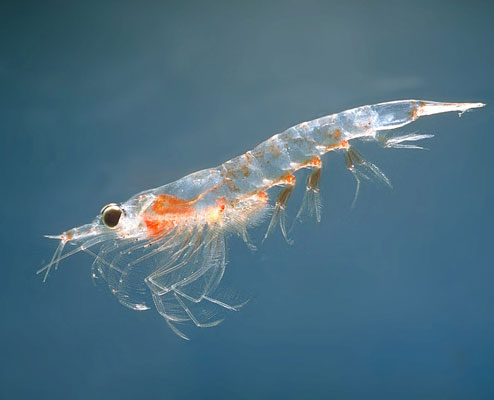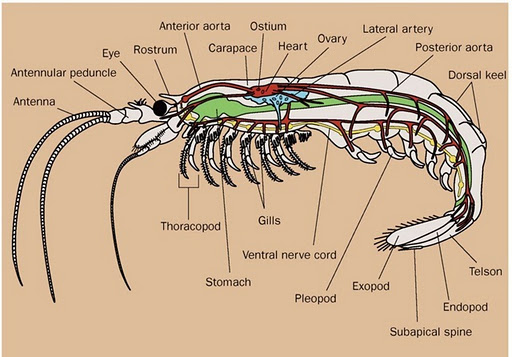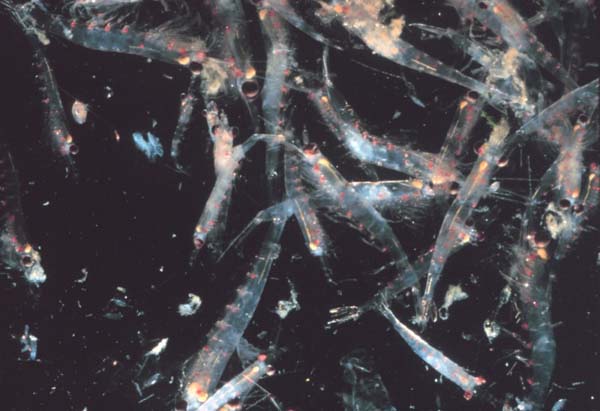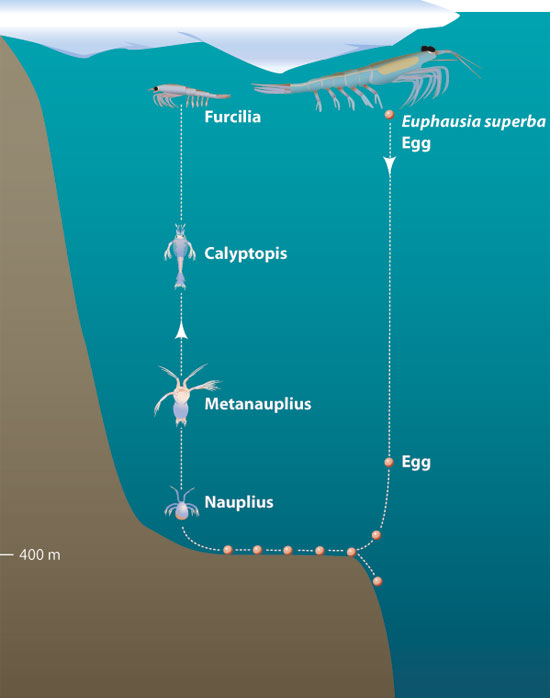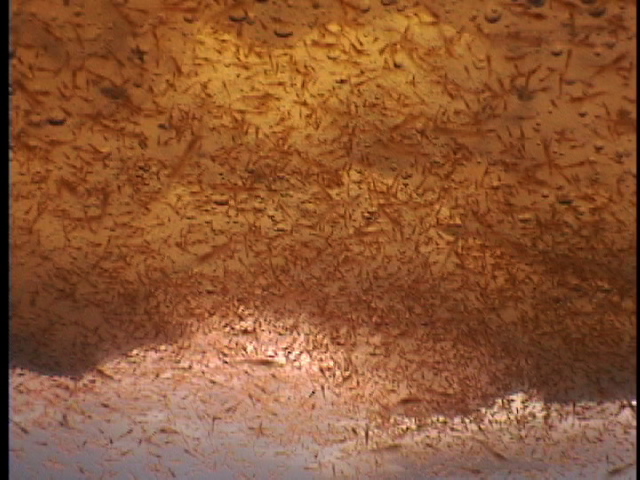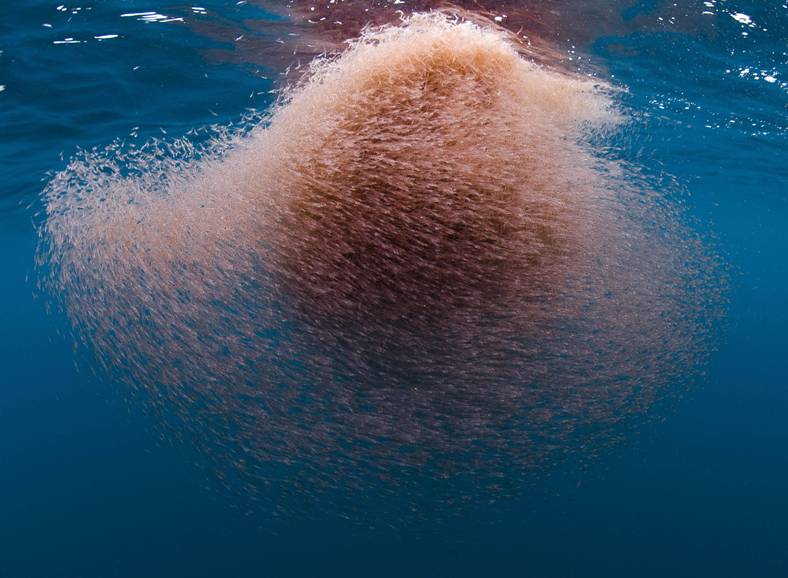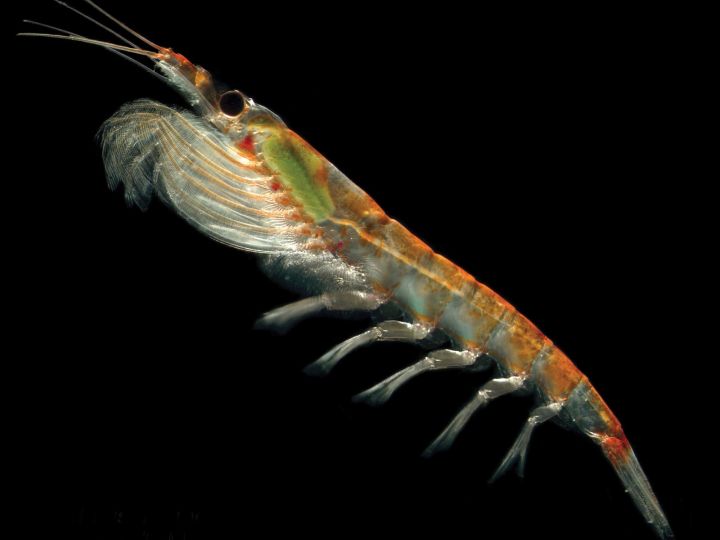|
Krill
Krill often are referred to as “keystone” species because they play such an important role for many marine systems.Krill, a Norwegian whaling term meaning "small fry", Krill are one of the most important elements in the Antarctic food chain. They feed on microscopic plants (phytoplankton) that float around the Southern Ocean. The krill, in turn, then become the basic food for baleen whales, seals, penguins and many seabirds.
There are two families of krill: the Bentheuphausiidae family, which consists exclusively of a deep-water species called Bentheuphausia amblyops, and the Euphausiidae family, which consists of 89 known krill species, including -- perhaps most commonly -- Euphausia superba, or Antarctic krill. Unlike Bentheuphausiidae krill, the Euphausiidae family is bioluminescent.
This means that Antarctic krill emit a yellow-green light that is thought to either camouflage the krill's shadow or aid the krill in mating or schooling at night. Krill are invertebrates that grow to about two inches in length and live in large schools, or swarms, as dense as 10,000 krill per cubic meter of water. Krill Life CycleCurrently, 85 species of krill have been identified in different oceans around the world. They live in habitats ranging from abyssal depths (5,000 m) to near shore kelp beds (10 m), and from warm tropical seas to the freezing Antarctic Ocean. The two most common species in the Sanctuary, Thysanoessa spinifera and Euphausia pacifica, are typically 15 to 20 mm long and probably live about two years. T. spinifera is found mostly in shallower water over the continental shelf. E. pacifica is usually found in deeper water toward the margin of the shelf and beyond.
A KRILL'S LIFECYCLE—Krill start life as eggs that sink and hatch in spring. They develop through larval stages as they swim back to the surface, reaching the fourth (furcilia) stage by winter. Krill that hatch at the depth of the Antarctic shelf (300-400 meters) can swim back to surface waters before winter and find phytoplankton to eat before they use up their stored supplies. Furcilia that make it survive their first winter by feeding on algae and zooplankton on the undersurface of pack ice. But krill that hatch in water deeper than 500 meters may starve before they can swim back to the surface, and food. (Illustration by Jayne Doucette, WHOI Graphic Services) All krill live in the ocean water column full time. They have legs called “swimmerets” that look like small feathers and function like fins. This gives them great mobility and agility for life in the water column. Krill feed while swimming, using modified legs to form a food basket that separates food from the water while they swim. Most krill hatch from free-floating eggs and pass through larval and juvenile stages before maturing into adults. This development process involves a series of molts (casting off the rigid outside skeleton that restricts growth), during which segments and appendages are gradually added. While the new outside skeleton is still soft, the individual can increase its size. Adult krill have the unique ability to actually shrink in size after a molt if food resources are scarce. Because krill can increase and decrease their size, it can be difficult to determine their age or an age distribution from a population of animals.
Formation Behavior Krill typically are found in concentrated aggregations. Like many organisms that live in the water column, aggregations of krill in the Cordell Bank area are very patchy. Usually, one to ten individuals occupy a cubic meter of ocean. However, denser patches called shoals have concentrations of 10 to 100 krill per cubic meter, and swarms have 1000 to 100,000 krill per cubic meter. This schooling behavior is an effective defense mechanism. It confuses smaller visual predators that prefer to isolate and take single individuals.
Within the aggregation, single krill are capable of some truly remarkable maneuvers. Researchers in the Antarctic have documented an amazing response by individual Euphausia superba. When the aggregation was disturbed by divers, krill scattered in all directions. Some individuals in the group instantaneously and synchronously molted, leaving behind only their floating exoskeletons. These castings presumably act as decoys to further confuse predators, allowing the krill to rapidly swim away, much like an octopus leaves behind an ink cloud. Swarming, however, does little to protect krill from the considerable risk posed by larger predators like great whales, who do not target single prey. Swarms can extend 10 m or more in diameter and often elicit a frenzied feeding response from whales and other predators like fish and birds. This is particularly true when these aggregations are in the upper water column, and escape routes are restricted by the ocean's surface.
Swarm formations at or near the surface have been reported for 18 species of krill worldwide. In the Cordell Bank area, Thysanoessa spinifera demonstrates this behavior by forming large swarms at the surface during daylight hours. Swarming activity starts sometime in the spring and continues through the fall. Often, we can locate these aggregations by spotting flocks of diving seabirds or clusters of birds picking at the surface. Fishermen often use these feeding flocks to help them locate salmon feeding on the undersides of the krill swarms. Lunging humpback whales that break the surface of the water are also a good indication that krill are swarming nearby. Surface swarms provide ideal feeding conditions for these large filter feeders. With its huge, gaping mouth, a humpback can engulf a large volume of krill in a single gulp. These dense aggregations of prey provide the several tons of food per day that these whales require during the summer feeding season. Scientists are unsure why krill form huge swarms at the surface during the day when it makes them so vulnerable to predation. Both physical influences and biological cues likely drive this swarming behavior. Some scientists think that physical factors, such as passive transport by tides or ocean currents, drive krill to the surface during the day. Other researchers believe that krill swarm at the surface to take advantage of increased feeding opportunities associated with higher phytoplankton densities. Or perhaps warmer surface waters lead to faster incubation times and therefore, a higher rate of reproductive success. However, these behaviors vary by species and location. Likely, a combination of several factors that change slightly from year to year contribute to the behavior. But if biological forces are involved, the presence of this daytime surface swarming behavior must provide a net benefit for the species. Advantages gained by daytime, surface swarming must outweigh the associated costs of increased predation. Although they do not form daytime surface swarms in the Cordell Bank area, our other common krill, Euphausia pacifica, demonstrates a behavior that is equally fascinating. Each night, as if on cue, these krill rise from the deep ocean into the upper levels of the water column. As dawn approaches, they descend to ocean depths for the day. Many other organisms share this migration pattern. During the day, krill form part of the so-called “deep scattering layer” that fishermen see on their depth sounders. The timing of this daily event in response to changing light intensities provides E. pacifica with advantages relating to predation, feeding, energy and reproduction. By moving up at night to graze on abundant food, E. pacifica minimizes its exposure to certain daytime predators. They also conserve energy by returning during the day to the colder deep water where their metabolism slows and converting food into energy and growth is more efficient. In addition, releasing eggs in the warmer surface layers speeds development times and reduces the time exposed to predators. It also ensures that hatching larvae are in productive waters when they start feeding, thus increasing their chances of survival.
Antarctic krill live in the surface waters of the Southern Ocean, which extends north from the Antarctic continent to the polar front -- an area where the cold water of the Antarctic submerges beneath the warmer waters of the Atlantic, Indian, and Pacific Oceans. As this deep, cold water rises to the surface of the Southern Ocean, it brings nutrients from all the world's oceans into the sunlight, making this area home to what is possibly the earth's largest assemblage of phytoplankton. It is this massive gathering of phytoplankton that allows for such tremendous swarms of krill, which harvest the miniscule phytoplankton particles with a specially developed feeding basket that filters them out of the water. The krill also find nourishment by scraping ice algae off the underside of pack ice, particularly in spring. These are successful techniques, apparently, since the total biomass, or weight, of Antarctic krill -- which is estimated to be between 100 and 800 million tons -- may be the largest of any multi-cellular animal on the planet.
redit: British Antarctic Survey, New Zealand Antarctic Program, Seal Conservation Society, U.K. Royal Navy,NOAA |

